Adding LED's to Objects
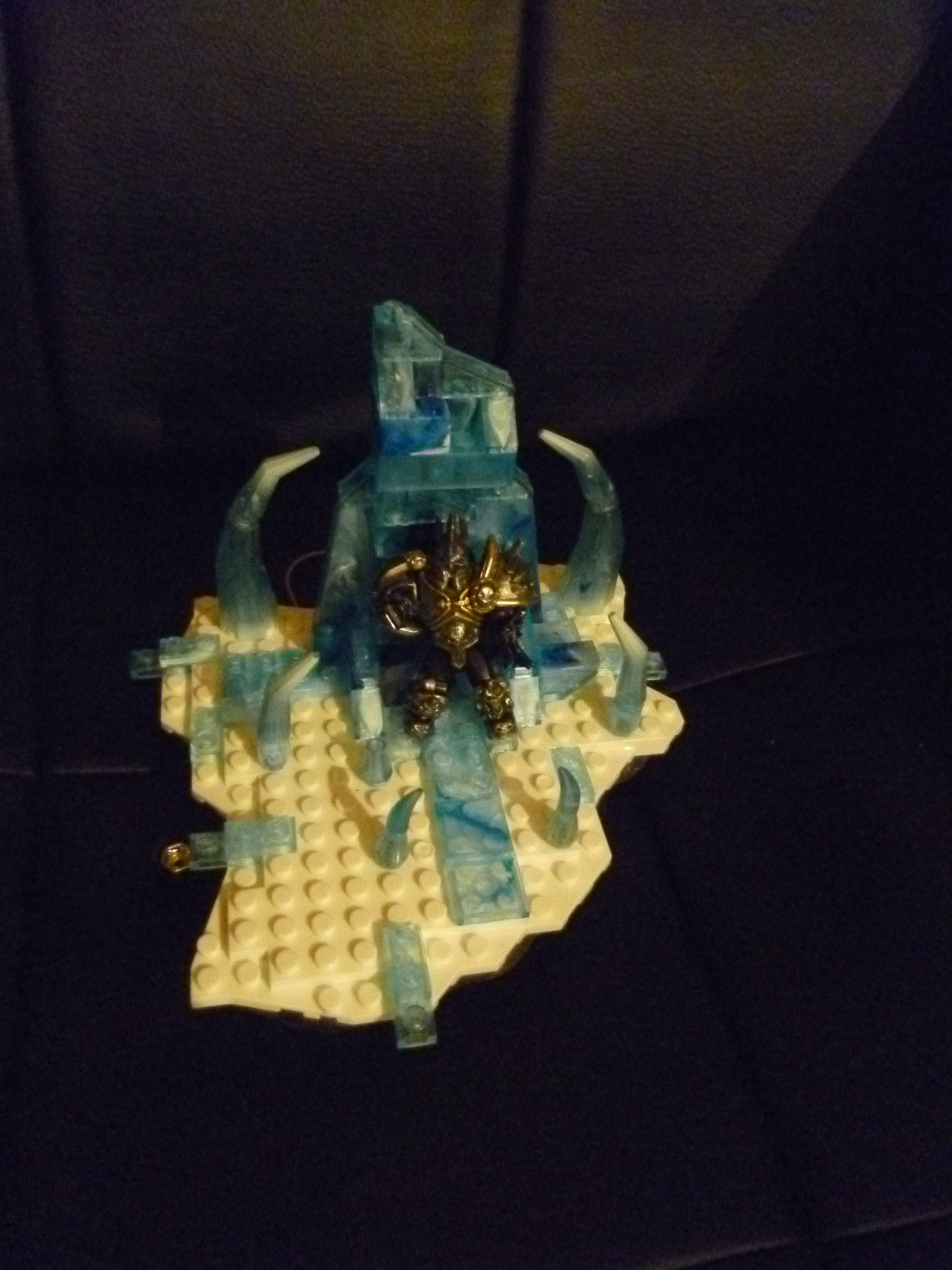
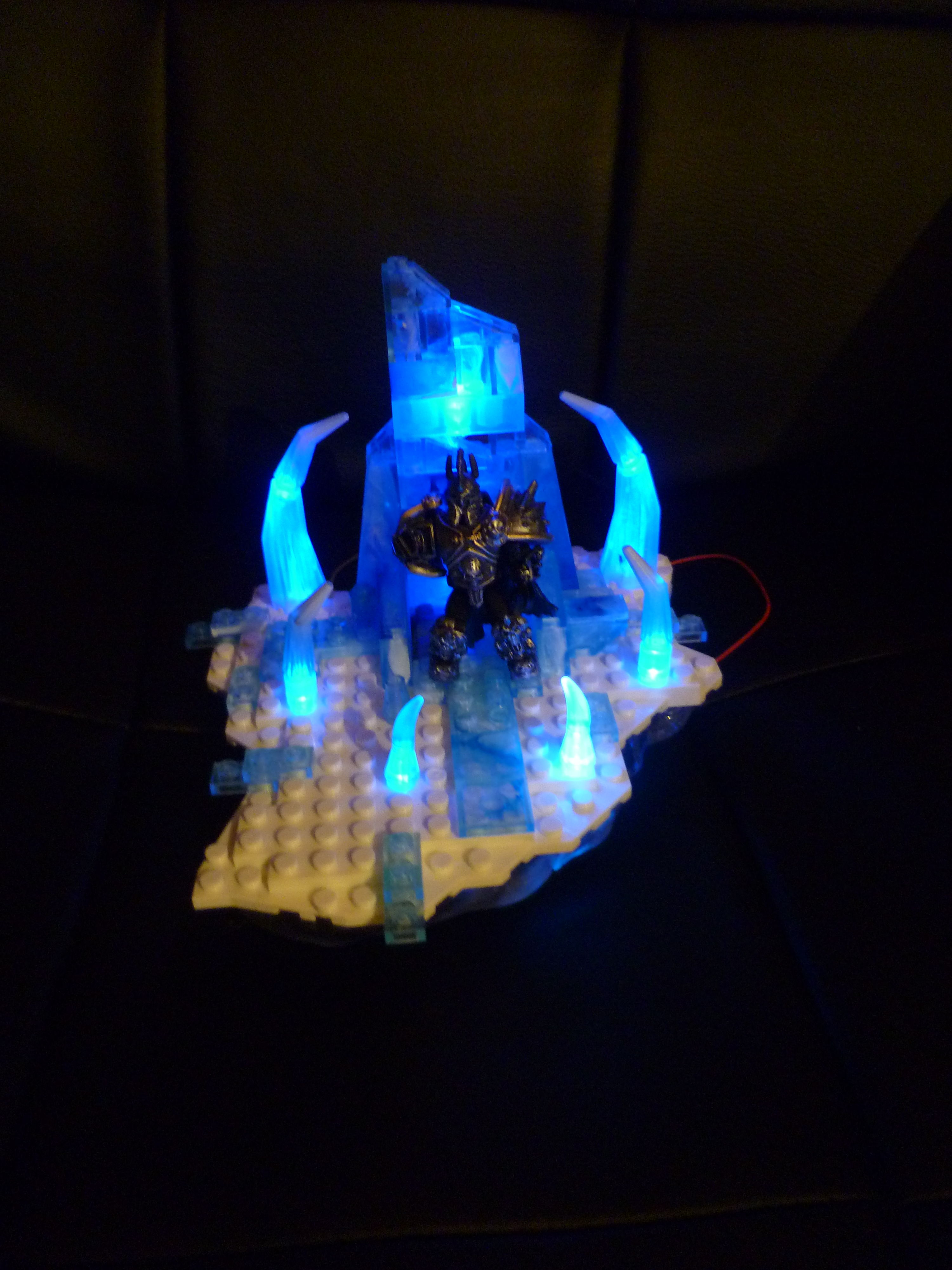
Welcome to My LED Tutorial Welcome this tutorial on how to add LED's to items, to give them that extra sparkle! Please note my methods are one of many different way of doing this, so if you see me doing something different to someone else then remember these are my 'preferred' methods =).
Getting Started
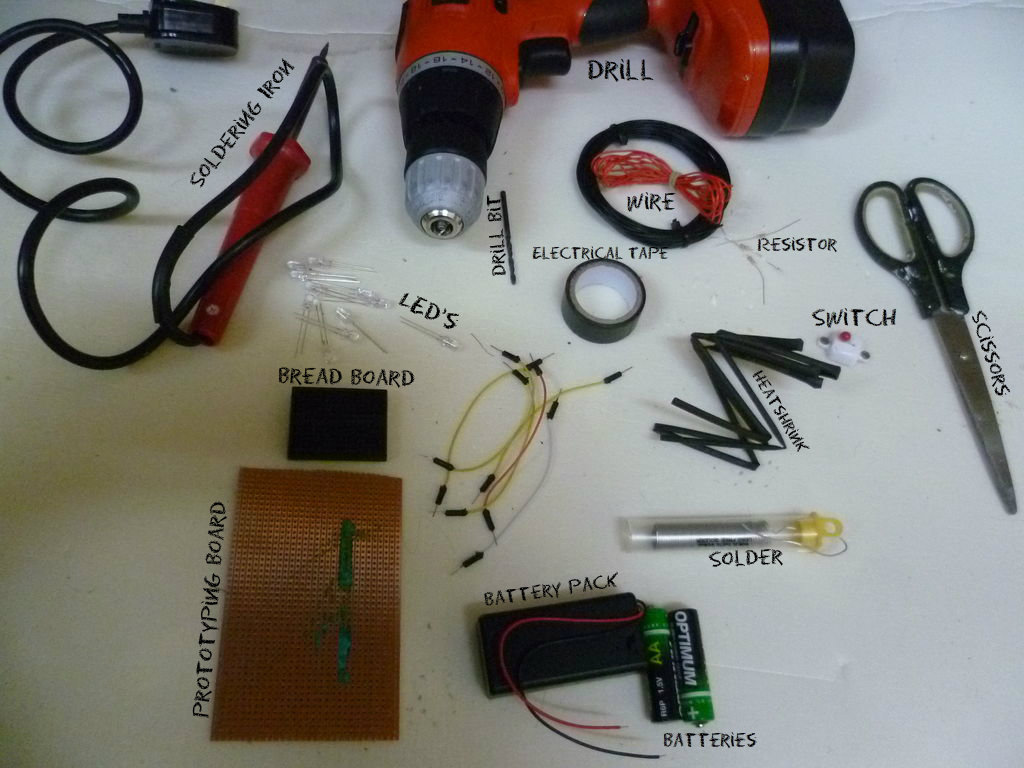
Welcome to My LED Tutorial
Welcome this tutorial on how to add LED's to items, to give them that extra sparkle! Please note my methods are one of many different way of doing this, so if you see me doing something different to someone else then remember these are my 'preferred' methods =).Things to Consider
- You need an appropriate item to add the LED's to, (Clear items like the transparent Lego blocks in the example work best)
- Do you have room to add the battery pack?
- Do you feel happy to 'edit' your object to add the LED's in (Requires drilling)
Items You Need
An object to alterLED's of your choice
Prototyping Bread board
Prototyping Board
Wire (Easier with two different colour wires)
Batteries
Battery Pack
Resistor
Drill
Appropriate drill bit for size of LED
Clear glue
Solder
Soldering Iron
Scissors
Optional Items:
Heatshrink
Electrical tape
Switch
Jumper cable wire
Wire holder
Planning
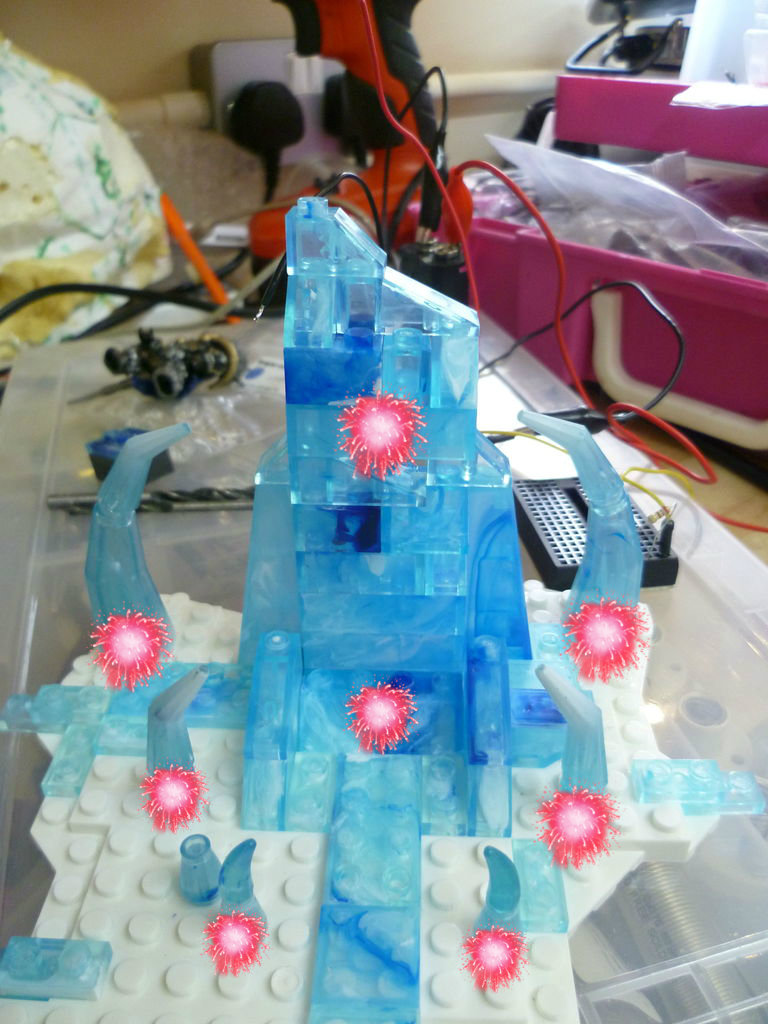
Before you start anything you need to plan where everything is going to go. This includes, where you want the LED's to be placed, where the battery pack will be, and optionally if you want to put a switch anywhere.
In my picture above I put red spoldges where I decided I wanted to put my LED's. I also decided to make a stand for this to sit on so for this particular project I didn't have to worry about where to put the batteries and all of the wiring.
In my picture above I put red spoldges where I decided I wanted to put my LED's. I also decided to make a stand for this to sit on so for this particular project I didn't have to worry about where to put the batteries and all of the wiring.
Drilling
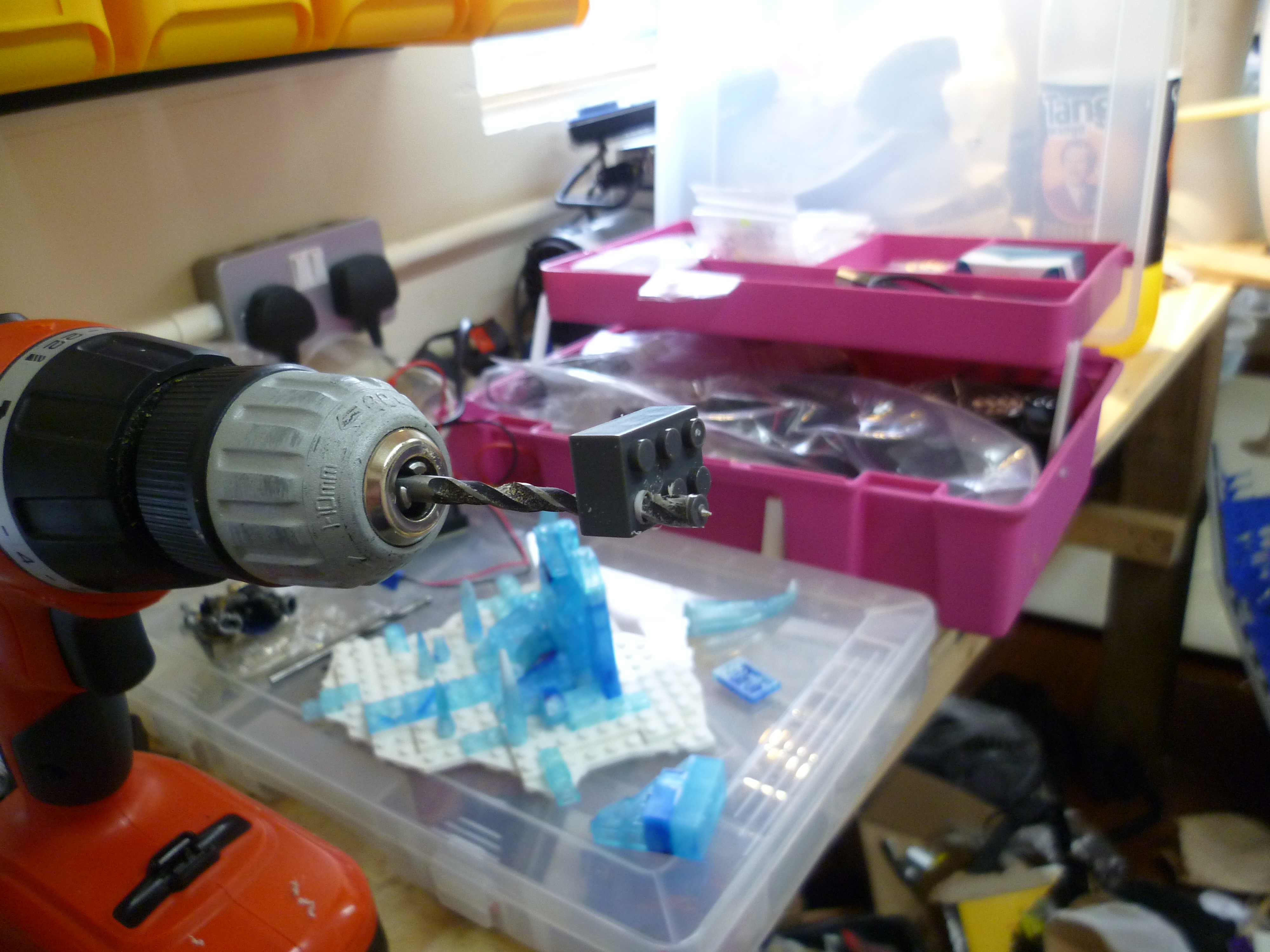
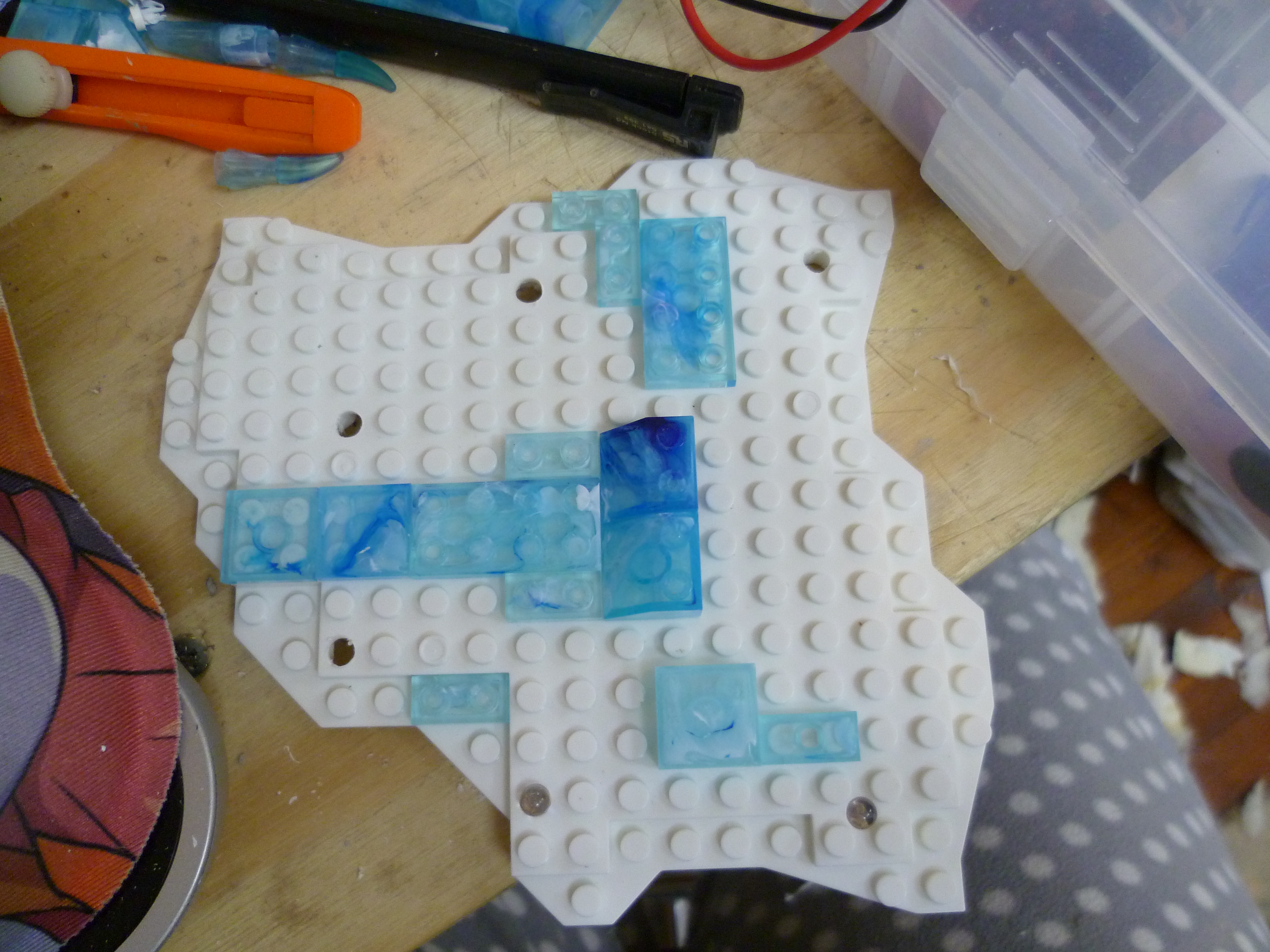
You first of all want to make sure you definitely have the right sized drill bit, or the LED won't fit in the hole, or it will become too loose and more likely to fall out. For my example project I had a spare piece of Lego and drilled into it, then attempted to push the LED through the hole. It was a tight fit, which was perfect.
Once you're happy you can make the right size hole you can drill all of the holes where you want the LED's to be placed.
Once you're happy you can make the right size hole you can drill all of the holes where you want the LED's to be placed.
Testing the LED's Work
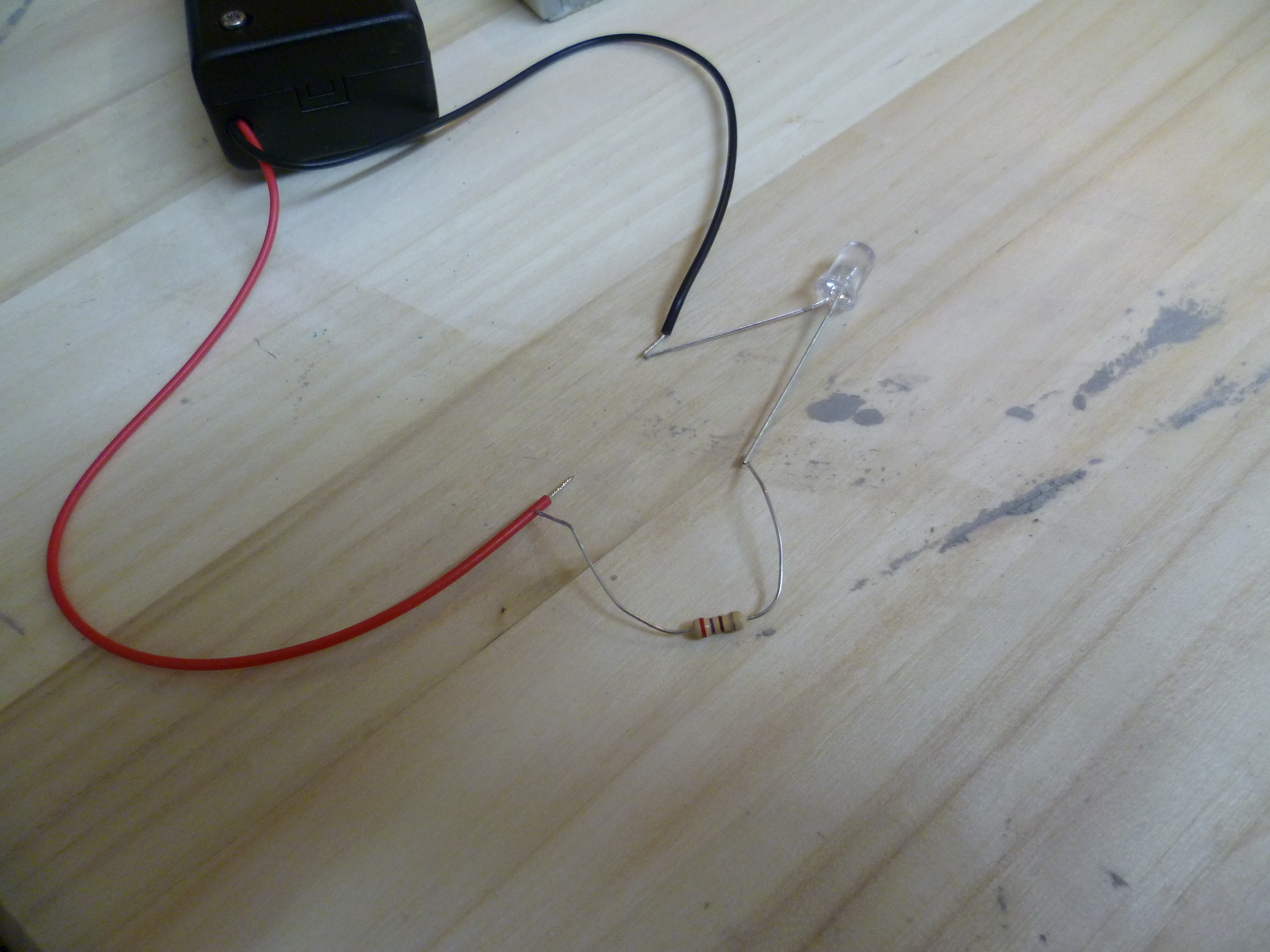
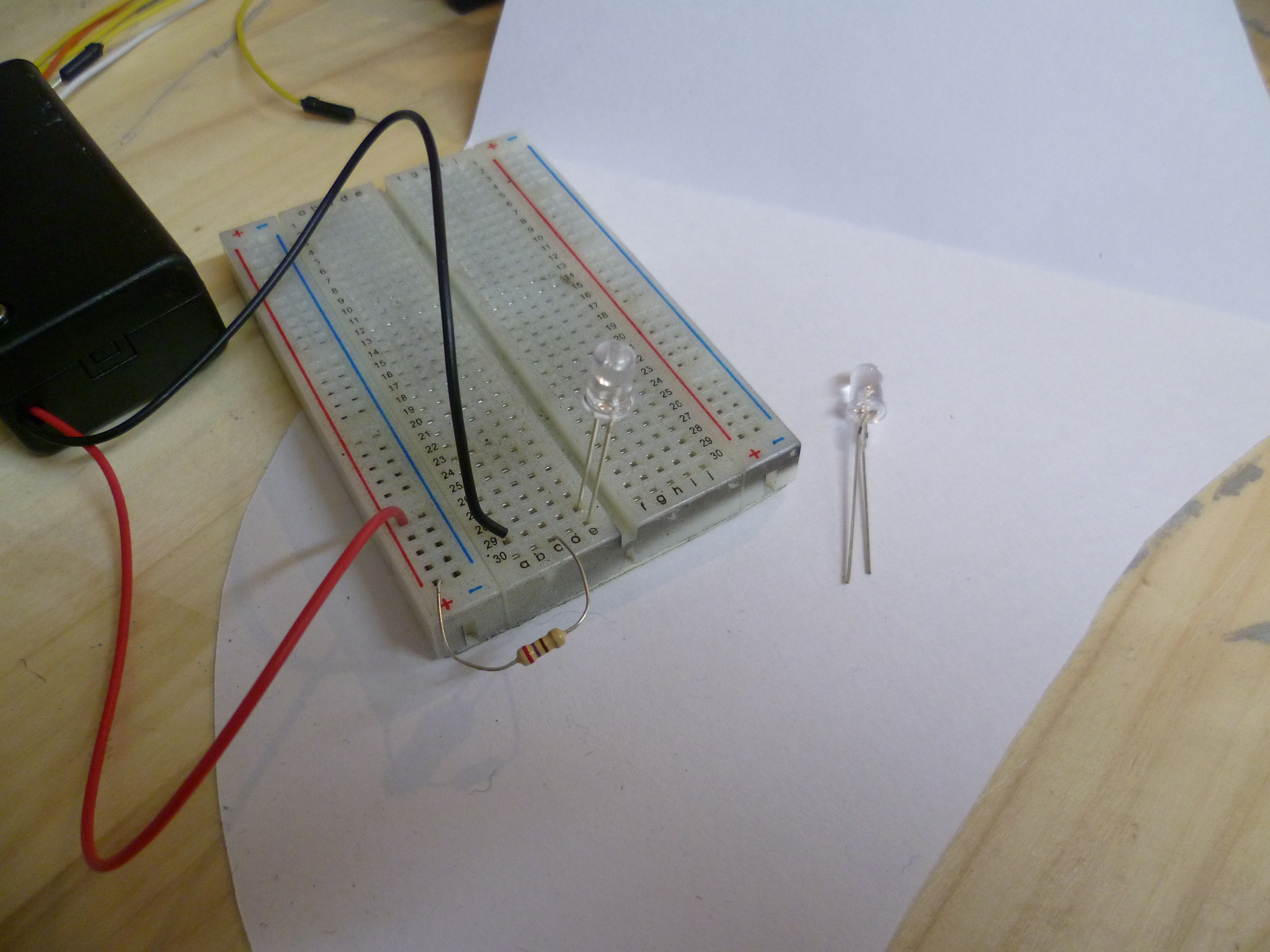
(I did end up using a different Bread Board then in the equipment photo, sorry)
When purchasing, don't always go for the cheapest, as it may mean the LED's could be very poor quality. When purchasing you want to look for information that looks like this:
Deciding what resistor your circuit needs can be quite difficult and is judged by the amount of LED's you want in the circuit, what battery power you're putting into the circuit, and what 'forward voltage' your LED's can handle (This information should be provided when buying the LED's).
This website: http://led.linear1.org/led.wiz is really useful at showing you what resistors to buy, as well as how you should wire up your project.
The first picture shows simply the circle that makes up your circuit.
To actually test your LED you want to bring your bread board to the table. In the world of electronics, red = positive and black = negative. For LED's you will notice they have two legs (wires) coming from the bottom. The longer wire = positive and the shorter wire = negative. This helps you connect the current in the right way. The second picture is the same layout as in the first, but simply pushed into the bread board (remember to put the resistor in or you risk the LED burning out). Resistors don't have a specific current direction, so it doesn't matter which way the colored bands go.
Buying the Correct LED's
For your final project to be a success you need the correct equipment, Buying LED's is quite simple and they're relatively cheap, but here is a pointer on what to buy: There are several different sizes and shapes of LED's, as well as different brightnesses. You need to research (on ebay for example) what is available, as there are too many to list here.When purchasing, don't always go for the cheapest, as it may mean the LED's could be very poor quality. When purchasing you want to look for information that looks like this:
"Brightness - 10000mcd"The higher the 'mcd' (millicandela) value is, the brighter the LED will be. 1,000 millicandela is equal to the brightness of one candela (Which is the brightness of one candle, hence where the name came from). Bear in mind the brightness of an LED can also be changed through the strength of batteries used and the resistor.
Buying the Correct Resistors
Putting a resistor in the electrical circuit with the LED's helps to protect them. Placing the resistor helps to control the current from the batteries and stops the LED's from being overloaded and 'burning out'.Deciding what resistor your circuit needs can be quite difficult and is judged by the amount of LED's you want in the circuit, what battery power you're putting into the circuit, and what 'forward voltage' your LED's can handle (This information should be provided when buying the LED's).
This website: http://led.linear1.org/led.wiz is really useful at showing you what resistors to buy, as well as how you should wire up your project.
Testing Your LED's in a Simple Circuit
It's always advised to test your LED's before putting them into a circuit, as you don't want to finish wiring everything up, then realizing that one of them doesn't work.The first picture shows simply the circle that makes up your circuit.
To actually test your LED you want to bring your bread board to the table. In the world of electronics, red = positive and black = negative. For LED's you will notice they have two legs (wires) coming from the bottom. The longer wire = positive and the shorter wire = negative. This helps you connect the current in the right way. The second picture is the same layout as in the first, but simply pushed into the bread board (remember to put the resistor in or you risk the LED burning out). Resistors don't have a specific current direction, so it doesn't matter which way the colored bands go.
LED's in Place
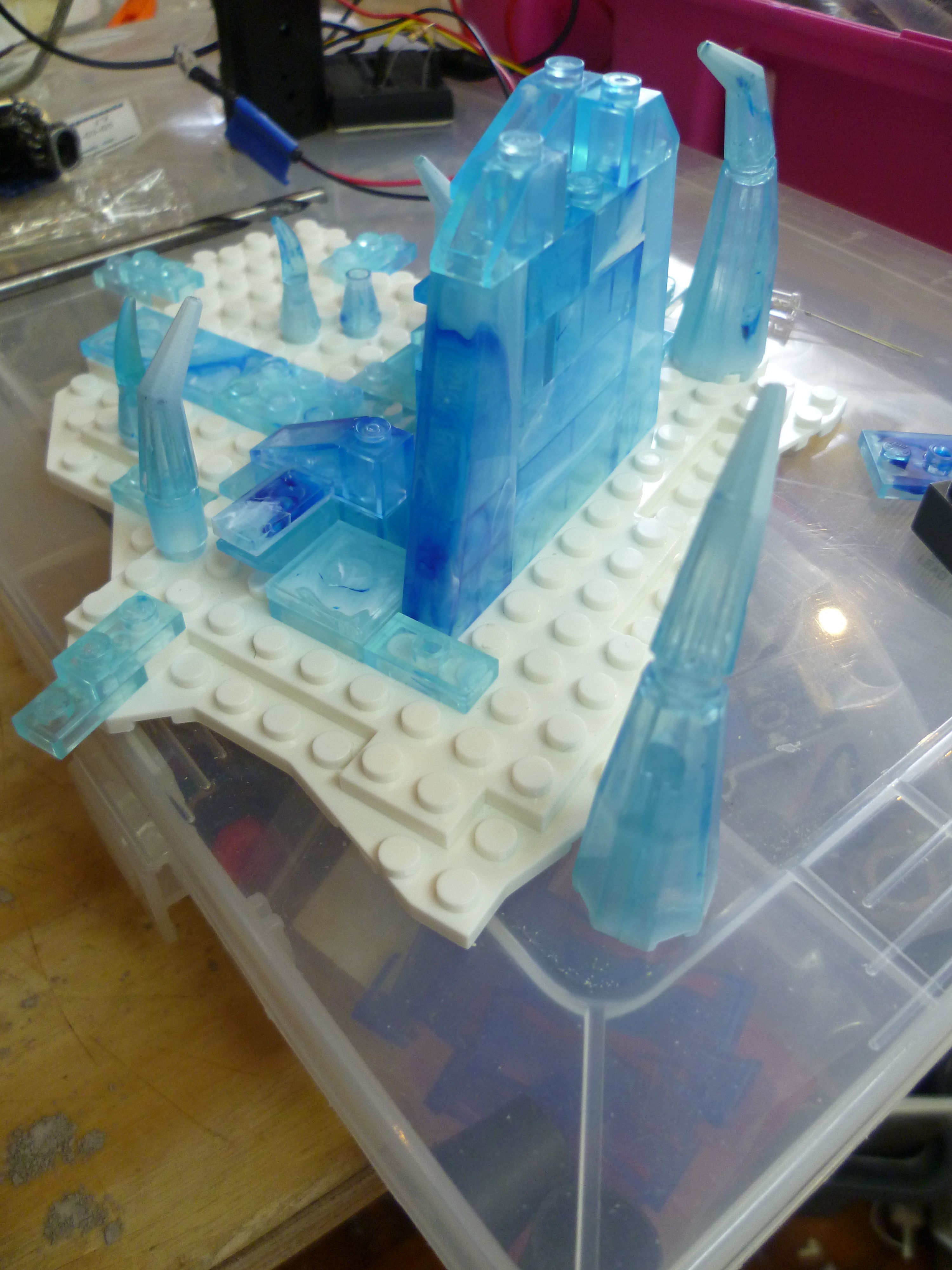
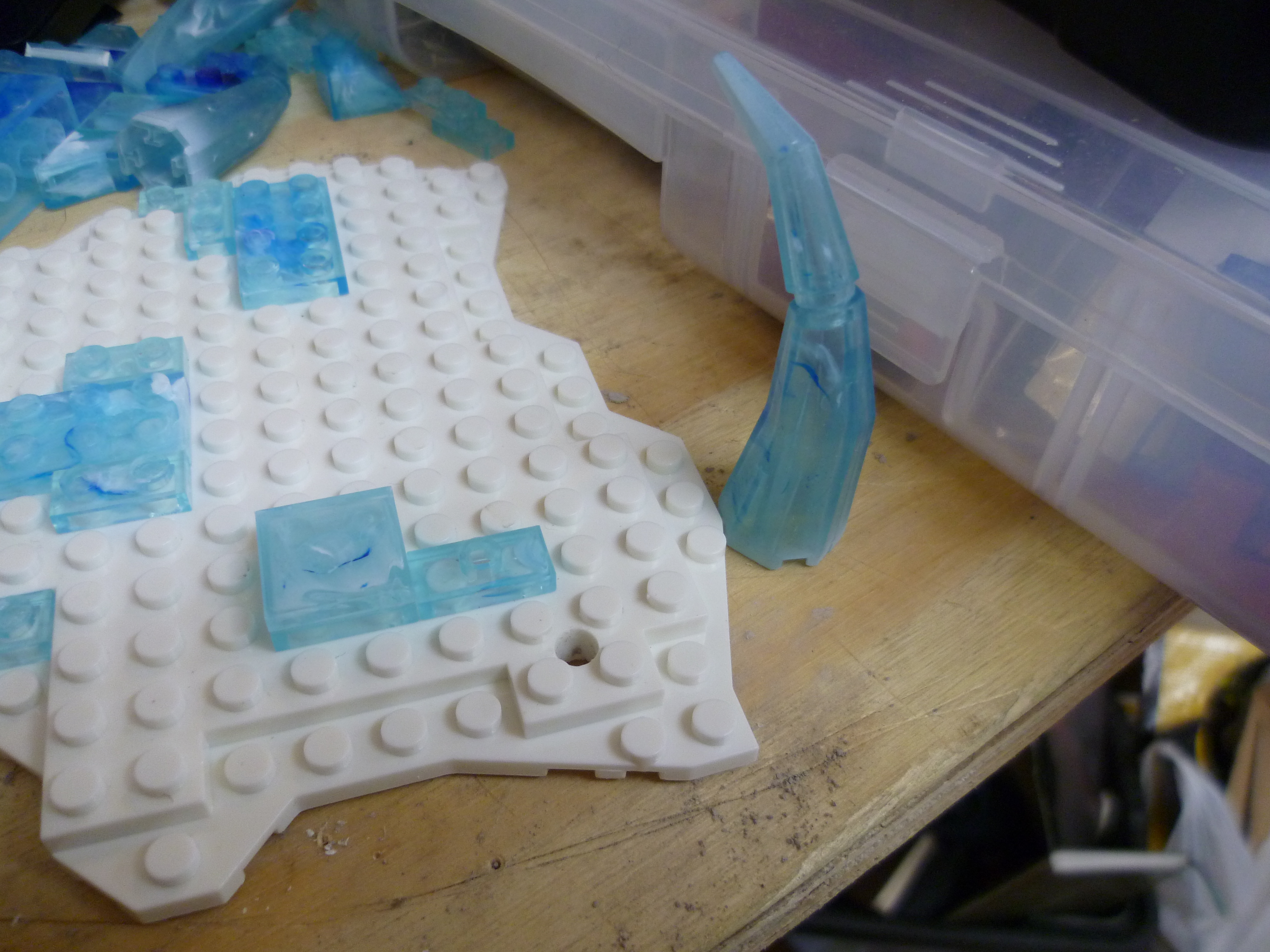
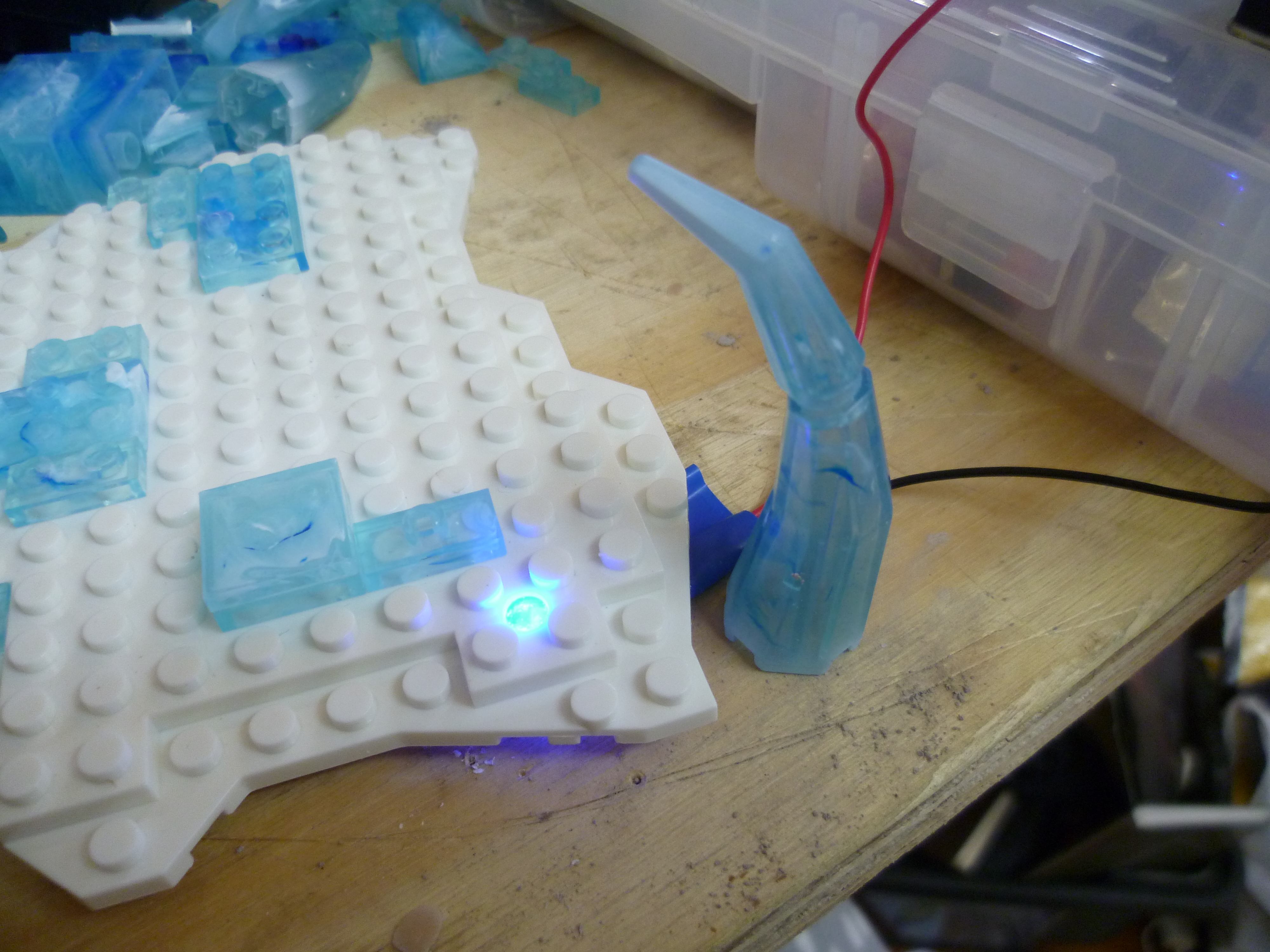
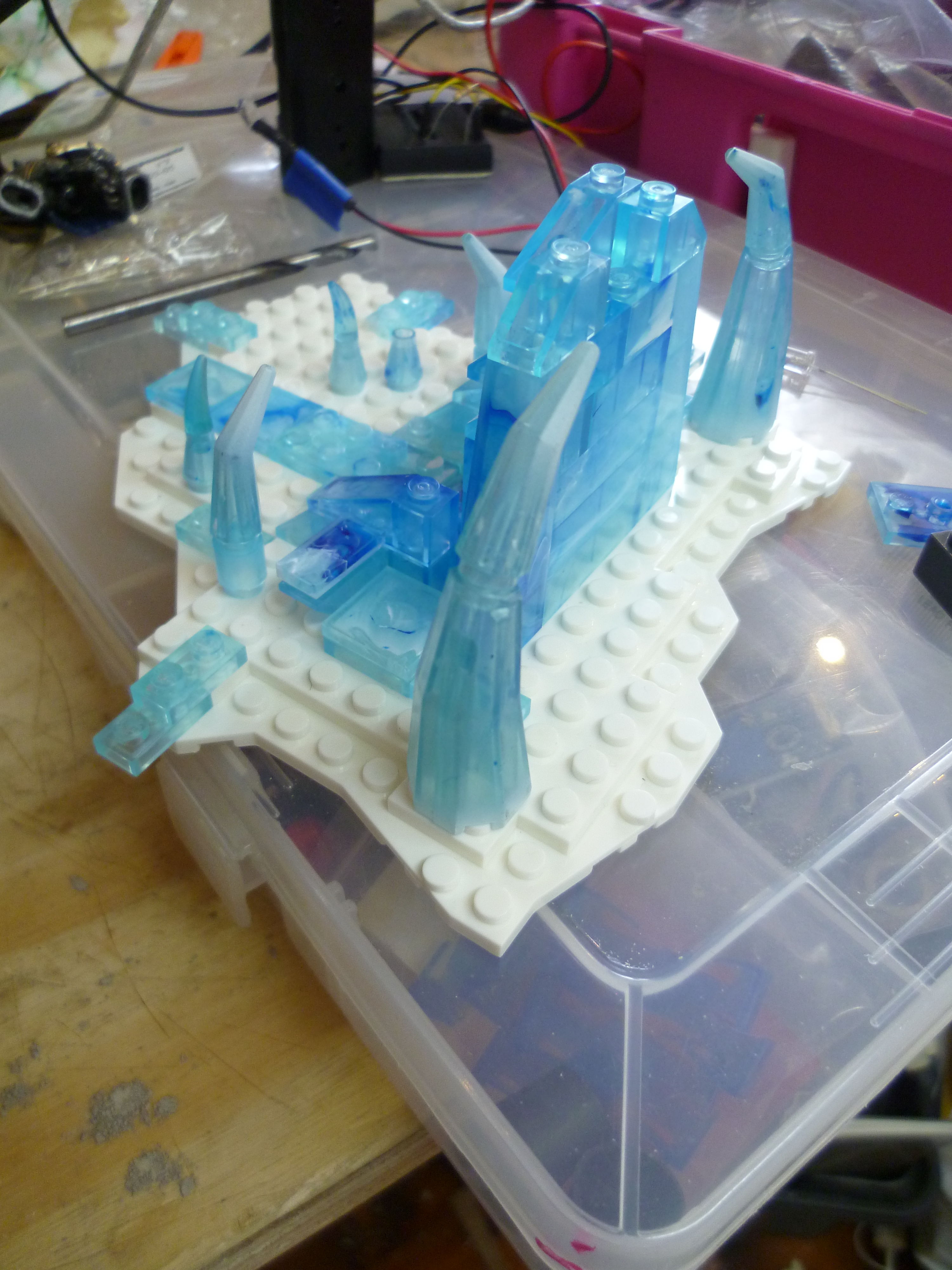
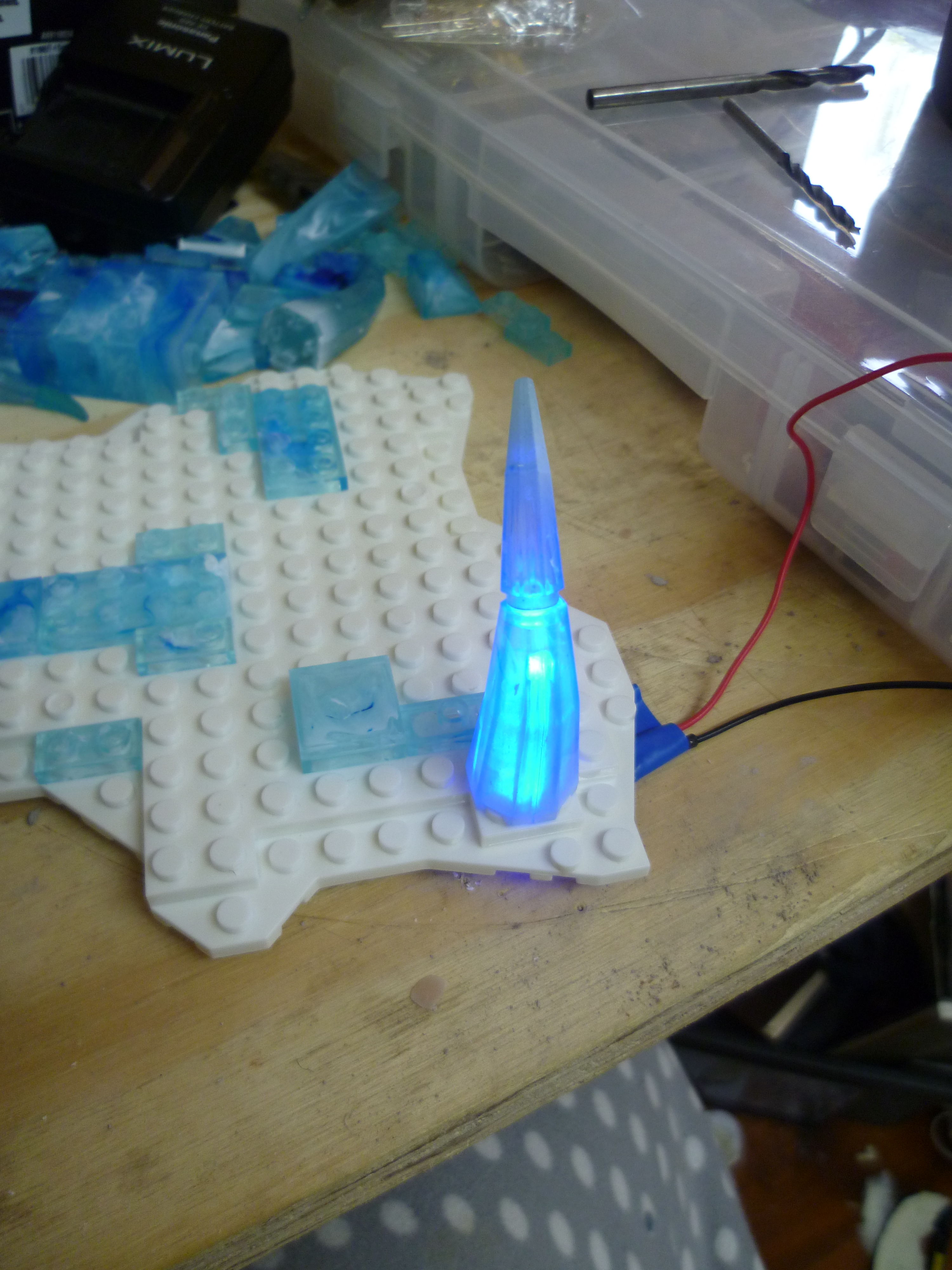
You can temporarily place the LED's into your item where you drilled the holes, and light it up to make sure you're getting the correct effect you wanted. The photo's above show the processes I've been through up till now on one of the positions in my Lego project.
Wiring the LED's
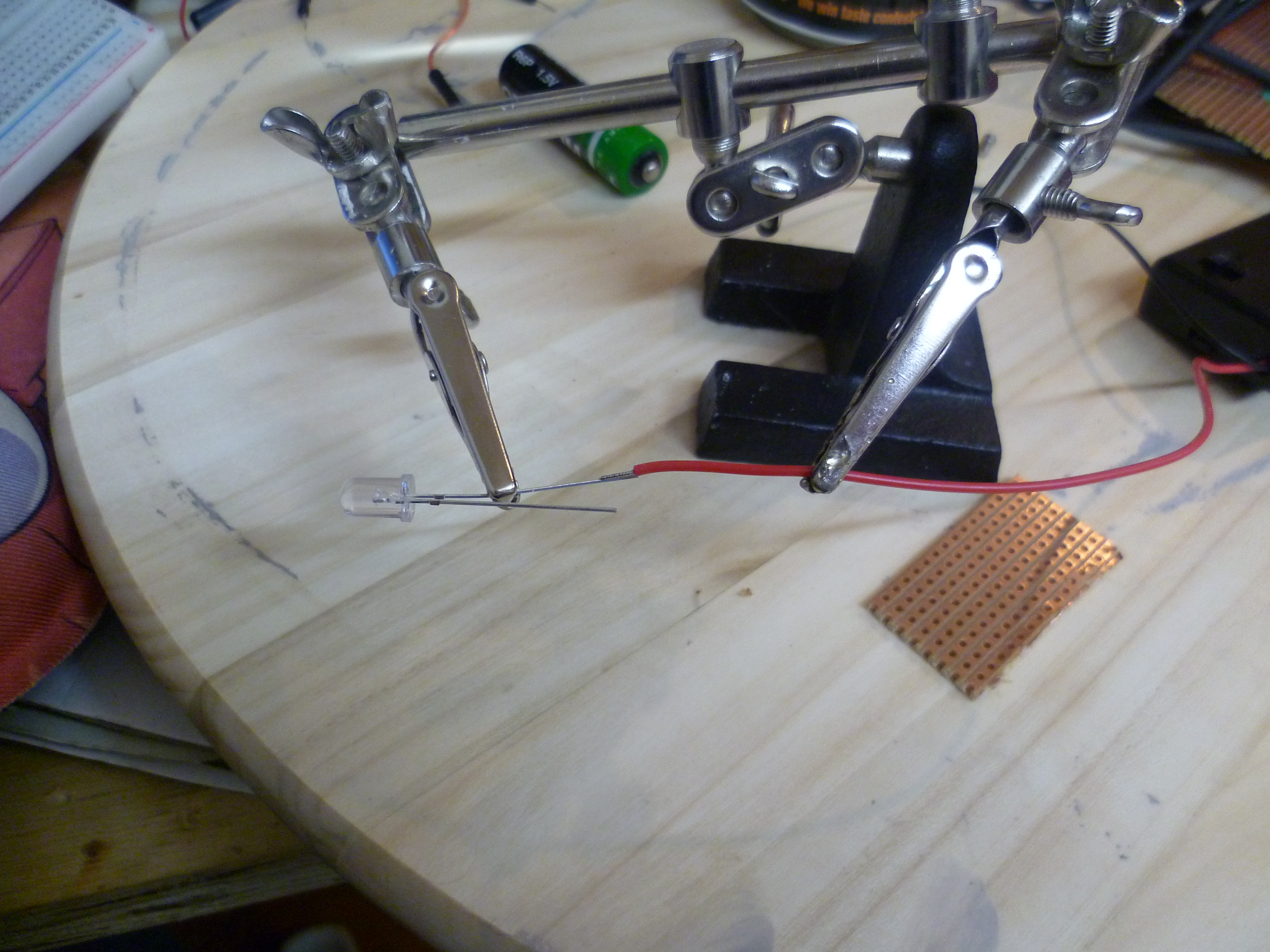
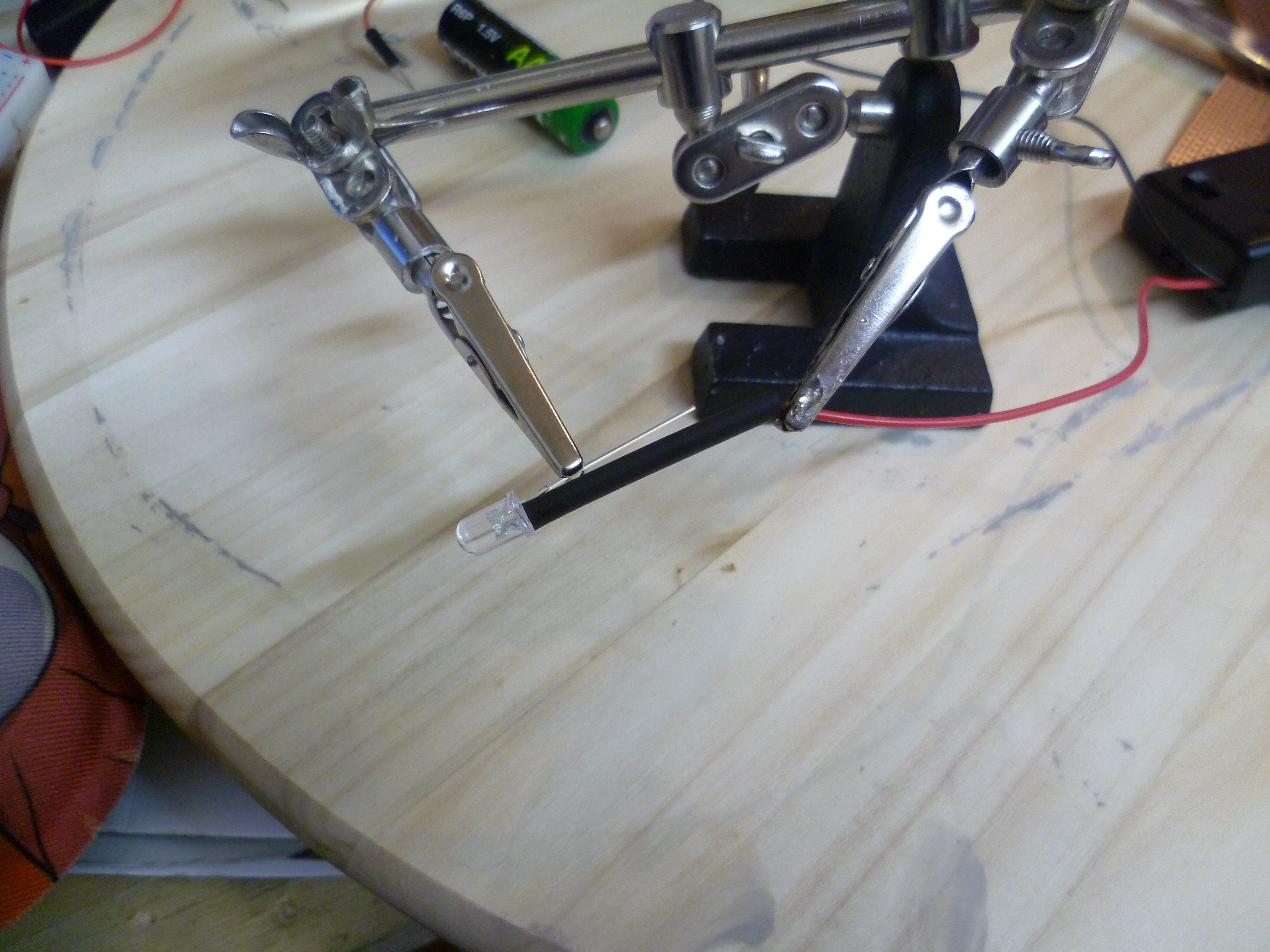
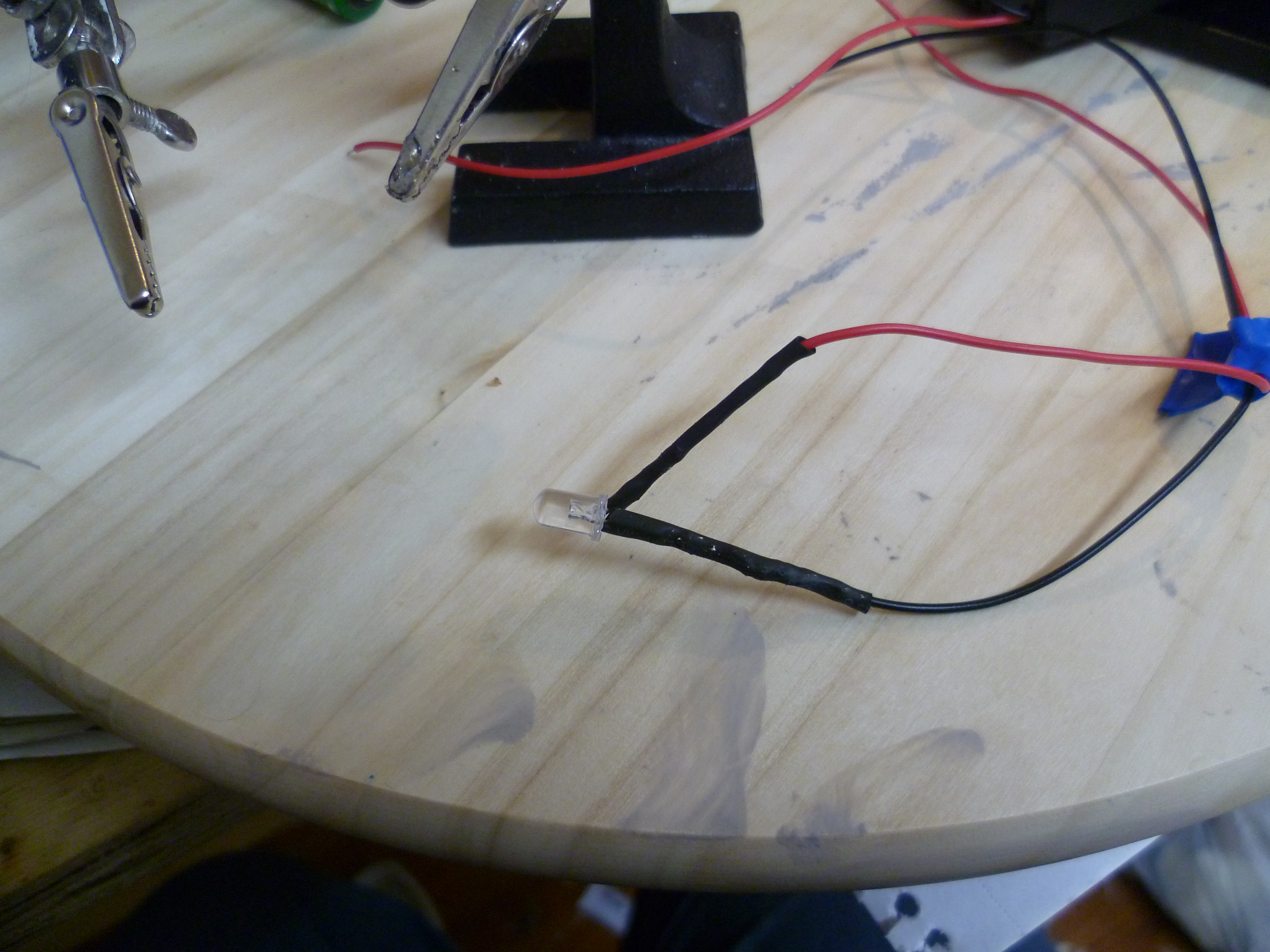
You firstly want to wire up your LED's!
You can use a device like I am to help you along, as trying to get the wire and the LED's legs to stay touching while you're trying to solder can be a nightmare otherwise!
So here are the simple steps:
You can use a device like I am to help you along, as trying to get the wire and the LED's legs to stay touching while you're trying to solder can be a nightmare otherwise!
So here are the simple steps:
- Set the soldering iron to heat up.
- Get the end of your wire (If you're doing the same as me, and using two colours, use the red here) and use some scissors to carefully cut away the plastic surrounding, so you expose the wire inside.
- Position the longest leg of the LED to the exposed metal in the wire.
- Hold the soldering iron in one hand and the solder in the other (I prefer to have the soldering iron in my writing hand so i have more control over it)
- Bring the two together so the tips meet and are also in contact with the wire and LED.
- The Solder will start to melt when it gets hot enough and will form a 'glob' of metal around the join, fixing them together.
- Repeat this method above for the shorter leg of the LED (but the other colour wire if you have one)
- Now that you have both legs wired, you want to grab a hold of your heatshrink. This stuff is magical and comes in different thicknesses, for doing something like this you'd only need a narrow piece.
- Slide the heatshrink over the join where you just soldered. You should use a piece long enough to cover all of the metal. This stops the two legs of the LED from touching and the current missing that LED, or simply short circuiting the entire thing.
- Once the heatshrink is in place, it's time for it to live upto it's name! Run the soldering iron along the surface of it, and watch the magic happen as it shrinks in size, encasing the join to help strengthen it.
- This should be what you end up with! A nicely wired and protected LED. Now you repeat the same above for any other LED's you want to put in your circuit. Remember to leave enough wire on the end of the LED's to reach the next thing you want in the circuit.
Placing the LED's
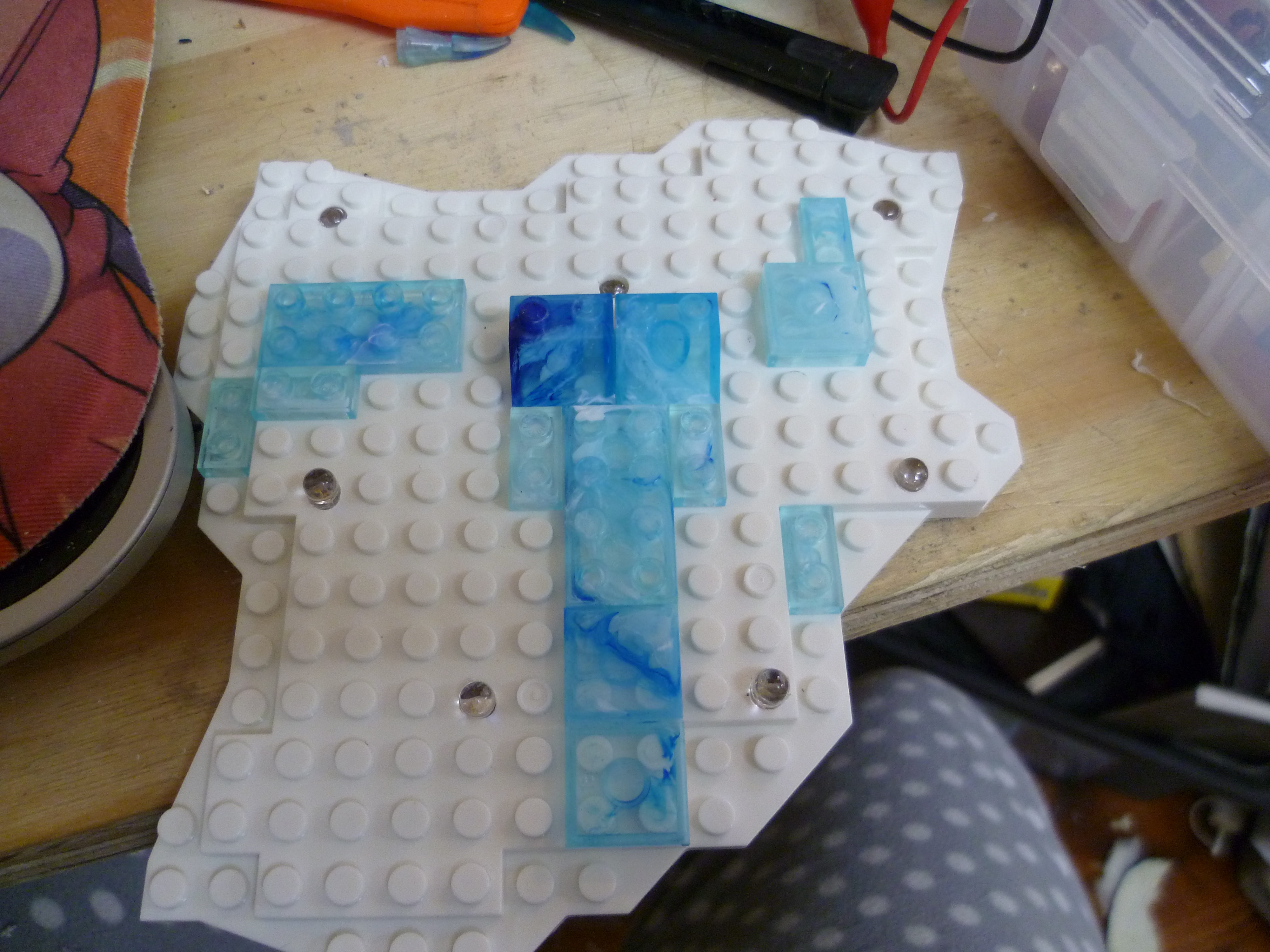
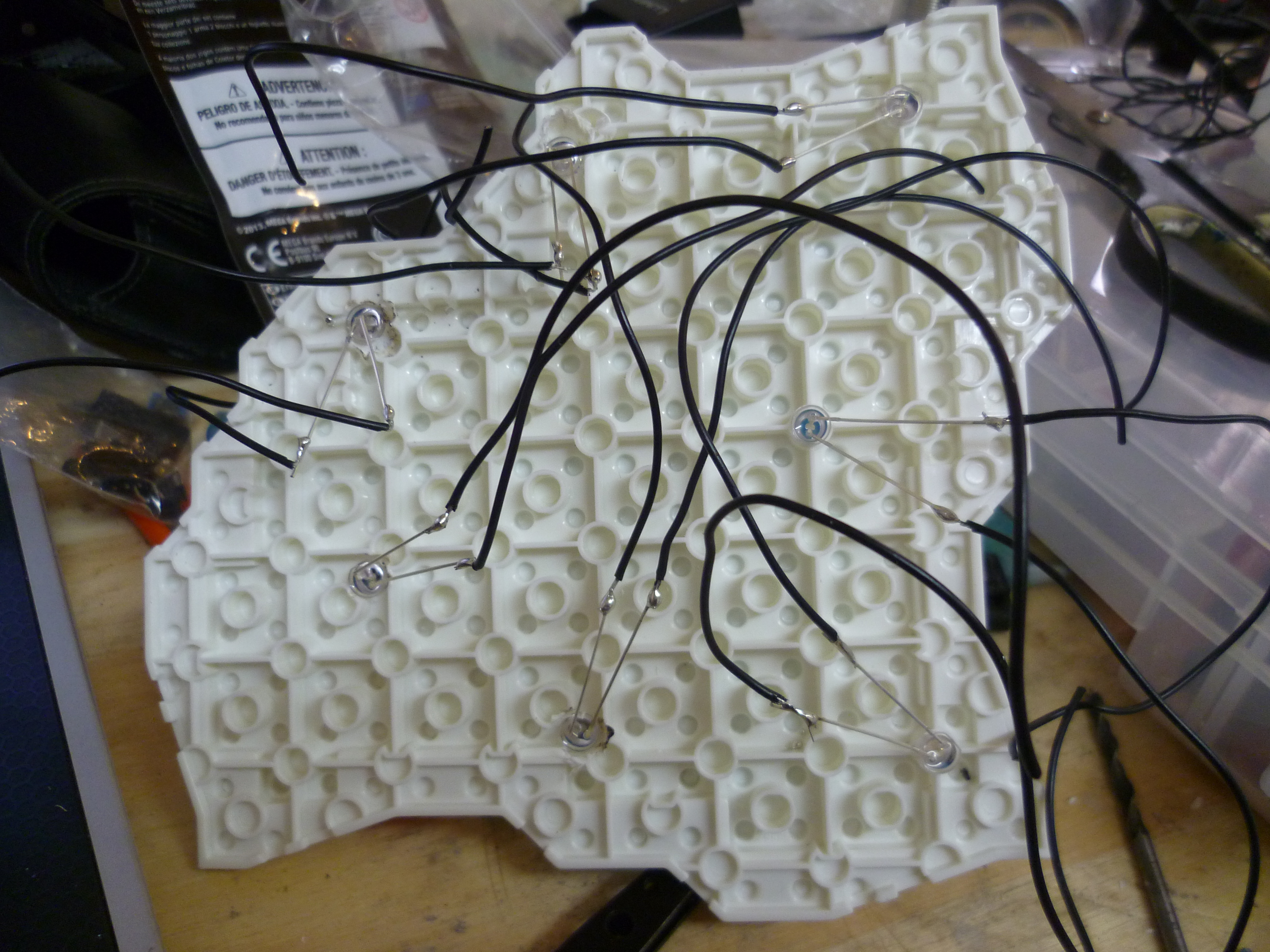
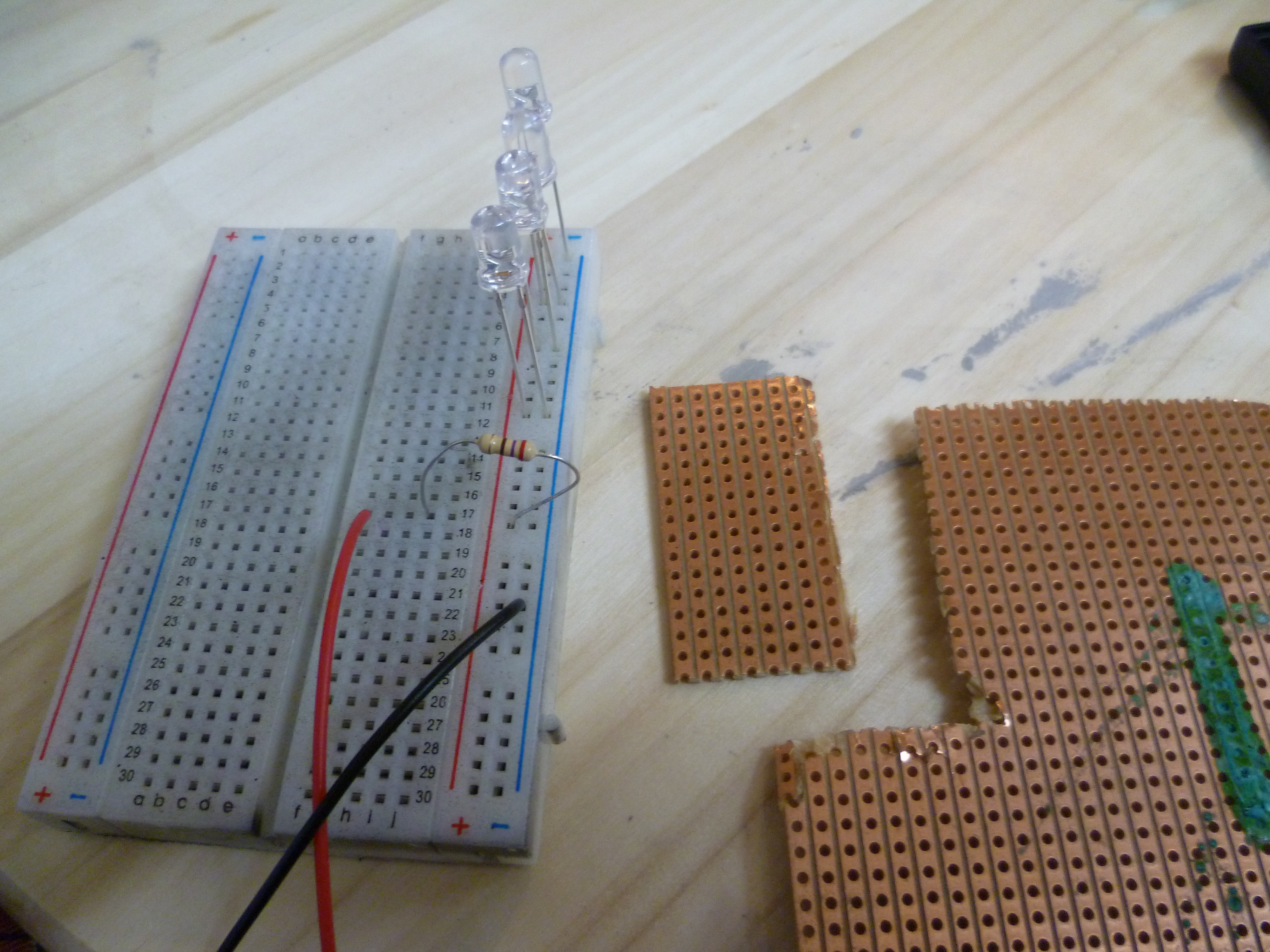
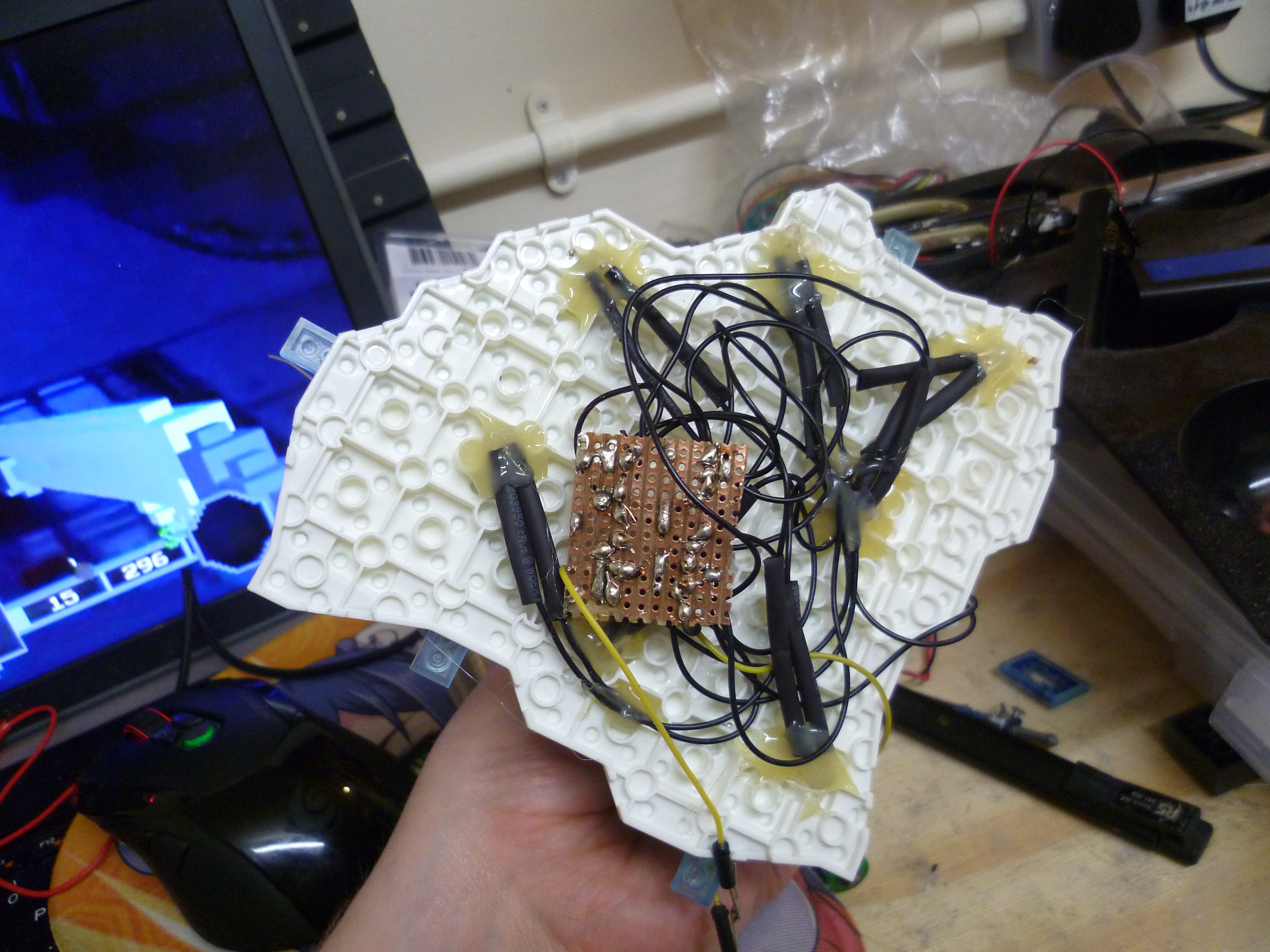
(Sorry my second photo doesn't have the heatshrink on yet, I took the photo's a while ago and am trying to write this tutprial in the most logical way)
(Picture 1 & 2)
Position the LED's in your item, it's upto you if you want to glue them in position now or wait till later, but just for now you want to see how much wire you will need left on the LED, so it can all be soldered together without inches of loose wire left floating around like in picture 2.
The prototyping board is a sheet of plastic, with lots of holes and one side is covered with a copper surface. This board will be where everything is attached. You want to cut this down to size so it will fit well with your object. Obviously the copper strips are what you use to make your circuit a circle to complete it. I'm not the best solderer in the world so I tend to leave a copper strip between each line I solder on so that the 'globs' of solder don't accidentally bridge between two lines and mess up the circuit.
In the breadboard you can see how I ended up wiring my LED's, only using one resistor in the circuit. I also ended up not putting in a separate switch, because the battery pack I used had a switch already on it.
(Picture 4)
When soldering your circuit to the Proto Board you want to (if you have one) again use things to hold it in place when you're soldering to make it as easy as possible. I have to appologise for my example in the picture, it was quite rushed. But I hope it gives you the idea of what you're looking to achieve. I used some hot glue underneath each of the LED's to give them a bit more stability as there would be pressure on them, in this instance when someone tries to press a Lego block onto it.
(Picture 1 & 2)
Position the LED's in your item, it's upto you if you want to glue them in position now or wait till later, but just for now you want to see how much wire you will need left on the LED, so it can all be soldered together without inches of loose wire left floating around like in picture 2.
The Prototyping Board
(Picture 3)The prototyping board is a sheet of plastic, with lots of holes and one side is covered with a copper surface. This board will be where everything is attached. You want to cut this down to size so it will fit well with your object. Obviously the copper strips are what you use to make your circuit a circle to complete it. I'm not the best solderer in the world so I tend to leave a copper strip between each line I solder on so that the 'globs' of solder don't accidentally bridge between two lines and mess up the circuit.
In the breadboard you can see how I ended up wiring my LED's, only using one resistor in the circuit. I also ended up not putting in a separate switch, because the battery pack I used had a switch already on it.
(Picture 4)
When soldering your circuit to the Proto Board you want to (if you have one) again use things to hold it in place when you're soldering to make it as easy as possible. I have to appologise for my example in the picture, it was quite rushed. But I hope it gives you the idea of what you're looking to achieve. I used some hot glue underneath each of the LED's to give them a bit more stability as there would be pressure on them, in this instance when someone tries to press a Lego block onto it.
Ta Da?
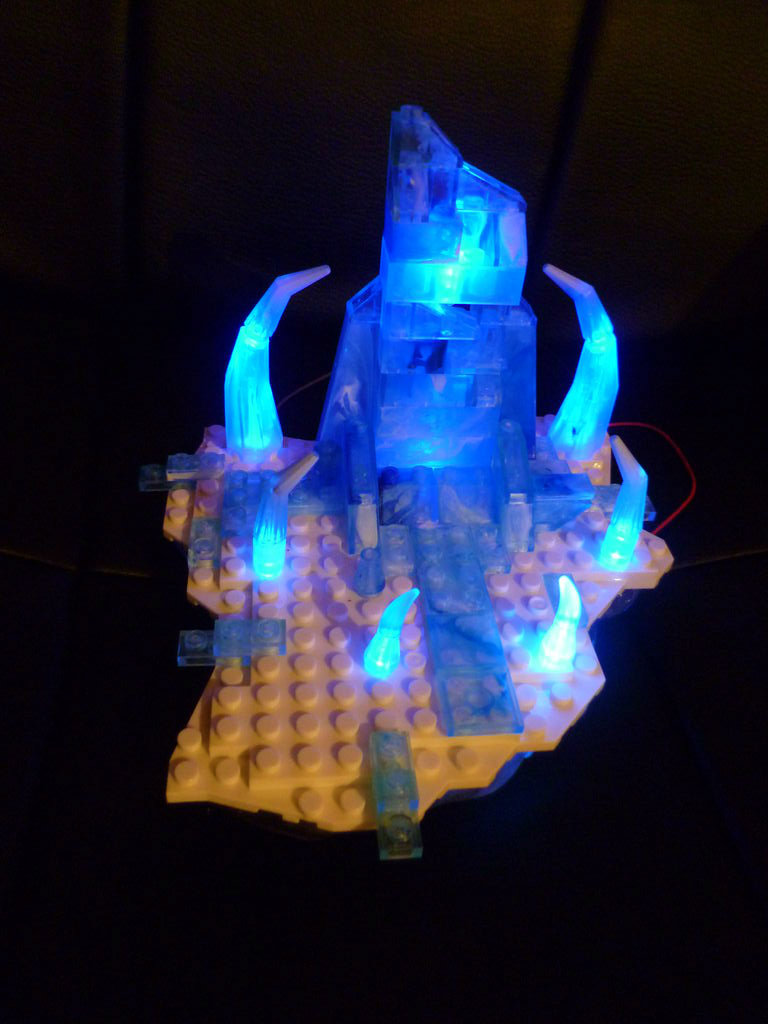
Hopefully if I've explained things well enough your object should now be glowing! Huzzah!
With the battery pack you will need to find somewhere to hide it, either inside, behind or underneath. With this particular project I just hid the battery pack behind the model, because it was going on a shelf anyway, it wouldn't be seen.
With the battery pack you will need to find somewhere to hide it, either inside, behind or underneath. With this particular project I just hid the battery pack behind the model, because it was going on a shelf anyway, it wouldn't be seen.
Thank You!
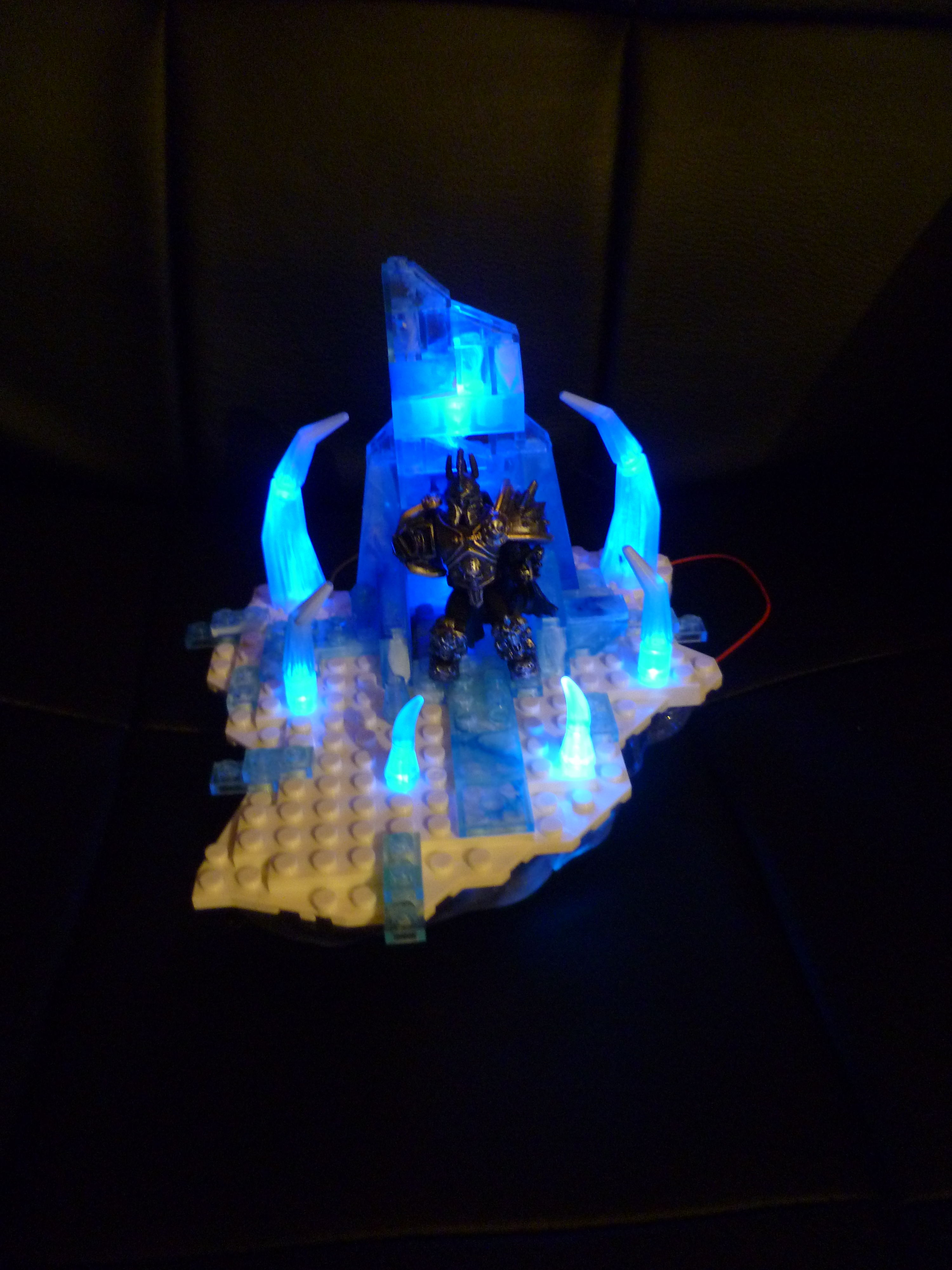
This is my first tutorial on here, so my apologize if I haven't explained something well, missed something out, or left spelling mistakes!
Many thanks for taking the time to read through, and I hope I helped at least one person ^^
Many thanks for taking the time to read through, and I hope I helped at least one person ^^